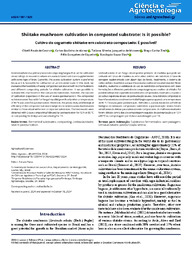Shiitake mushroom cultivation in composted substrate: is it possible?
Shiitake mushroom cultivation in composted substrate: is it possible?
Summary: Lentinula edodes is a primary wood-decomposing fungus that can be cultivated on wood logs or via axenic culture on sawdust-based substrate supplemented with some type of bran. Currently, the axenic cultivation system is preferred because it is favorable for cultivation on an industrial scale. In this work, we evaluated the feasibility of using composted substrates with two formulations and different composting periods for shitake cultivation. It was possible to cultivate this mushroom in the composted substrates; however, the success of cultivation depended on the use of severe pasteurization. The composted substrates were favorable for fungal mycelial growth only when a temperature of 80 °C was used for pasteurization. Moreover, the productivity and biological efficiency of the composted substrate subjected to severe pasteurization were similar to those obtained for non composted substrates. The best results were obtained with 6 days composting followed by pasteurization for 12 h at 80 °C or composting for 4 days and autoclaving for 1 h.
Publication year: 2024
Types of publication: Journal article
Unit: Embrapa Agroenergy
Observation
Some of Embrapa's publications are published as ePub files. To read them, use or download one of the following free software options to your computer or mobile device. Android: Google Play Books; IOS: iBooks; Windows and Linux: Calibre.
Access other publications
Access the Agricultural Research Database (BDPA) to consult Embrapa's full library collection and records.
Visit Embrapa Bookstore to purchase books and other publications sold by Embrapa.

